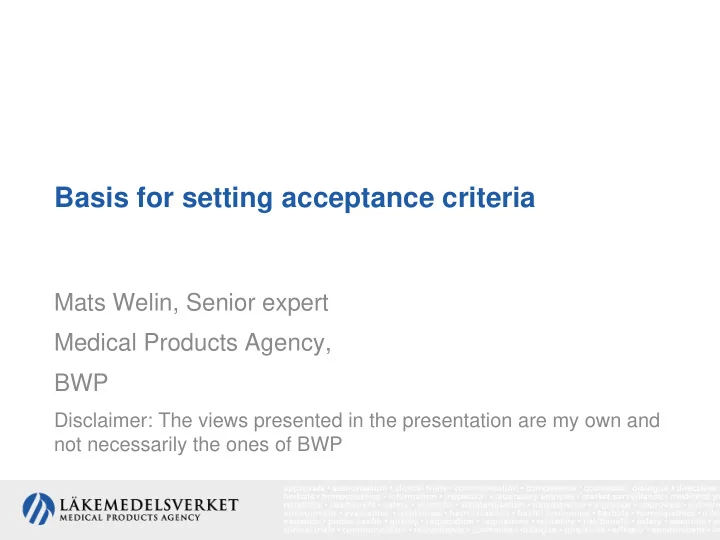

Basis for setting acceptance criteria Mats Welin, Senior expert Medical Products Agency, BWP Disclaimer: The views presented in the presentation are my own and not necessarily the ones of BWP
Fundamentals Q6B • “Characterization of a biotechnological or biological product …by appropriate techniques is necessary to allow relevant specifications to be established. Acceptance criteria should be established and justified based on data obtained from lots used in preclinical and/or clinical studies, data from lots used for demonstration of manufacturing consistency and data from stability studies, and relevant development data.”
Purpose of limits/specifications • Confirm intended potency • Confirm absence of critical contaminants and impurities • Confirm that the manufacturing process is under control (also to mitigate the risk of the ”unknown”) • Confirm that released lots are similar to lots tested in clinical trials
Dilemma • How can we find acceptance criteria that do not exclude ”good” batches because of normal variation but still is able to pick up outliers that are results of deviations in manufacturing process, starting material etc? – Based on characterisation studies appropriate, robust methods are chosen to mirror key aspects of the product in question. – As a consequence deviations from the normal in tested attributes may, even if within qualified limits, indicate deviations in attributes not tested for.
Regulatory concerns • Clinical qualification are considered the most important aspect when setting the acceptance criteria. – Acceptance criteria applied for critical attributes should not be wider than what has been clinically qualified. – Acceptance criteria for non-critical attributes can be based on process capability allowing wider limits than what have been used in the clinical trials
Key issue • Often only few batches are used in the clinical trials and these may not cover the full span of normal production variability. How to reach acceptable limits to avoid unnecessary rejection and still be able to claim clinical justification?
Considerations • What prior knowledge (e.g. platform knowledge) can be used in claiming clinical justification? Not all clinical studies look at relevant parameters (e.g. immunogenicity) to verify if certain product related forms gives rise to antibody formation or not. • Dose finding studies can be useful- even if the content of a particular impurity expressed in % may be below the proposed limit, the actual exposure should be accounted for (e.g. results from 2x dose studies may justify a higher % than used in the studies of the chosen dosage)
Considerations cont . • Non-clinical data could be useful in justifying acceptance criteria but normally the concern in relation to impurities in biotech products relates to immunogenicity rather than toxicity and the value of non-clinical data are therefore limited. Could be used for other aspects though • Drift in e.g. glycosylation or charge pattern where a form already exposed to humans increases or decreases may be less critical than the appearance of a completely new form.
Pitfall • Validation should show that commercial process result in a product that falls within clinically qualified limits, not the specifications in force during the clinical trials which may be much wider. – Reference to acceptance criteria applied in the clinical trials is not sufficient to justify commercial acceptance criteria.
Use of statistics in claiming qualification. • Proposals have been made to apply method variability to results seen in clinical trials- e.g. clinical trial point estimates +/- 3 SD claiming that the ”true value” of the batch used in the studies could equally well have been something else. True, but could also equally well have been something on the other side of the span i.e. the result seen in the trial material could be the “true” value + 3SD.
Use of statistics in claiming qualification cont. • It is not deemed appropriate to add method variability as determined in validation studies to the variation seen in batch results ( i.e. specification = batch results +/- 3SD + method variability) when justifying a specification as this variability is already included in the batch results and therefore will be counted twice
Use of stability results in setting acceptance criteria • By default used when changes are seen during storage to set release limits to assure a clinically qualified shelf life limit • It is not appropriate to add results from stability studies (t=3,6,9… months etc) of the same batch to the pool of batch analysis results in setting acceptance criteria at release even if no changes are seen during storage as these results are only showing the method variability and not the sum of variability of a particular attribute (content etc.) and its test method. Could however be useful to check variability over time. • Age of material used in clinical trials can be used in justification of acceptance criteria .
Ph Eur • Ph Eur mandatory if monograph exists. • to be considered as minimal requirements- should be fulfilled but stricter requirements may be required – e.g. Ph Eur monograph fulfilment is not sufficient for biosimilarity claim. Consequences for stand alone products?
Key question • Is it possible to separate clinical justification and consistency in setting acceptance criteria? – To base the regulatory requirements on the clinically qualified levels – To handle consistency (process capability) through the company´s PQS (e.g. alert/ action levels) where the principles are described in the dossier ( e.g. what are the principles applied in the assignment of the alert/action levels and what kind of action is taken if results are outside these limits) to assure regulators that things are under control. • Not to be considered as an overall approval of the PQS as such as this is GMP
Thank you for listening
Recommend
More recommend